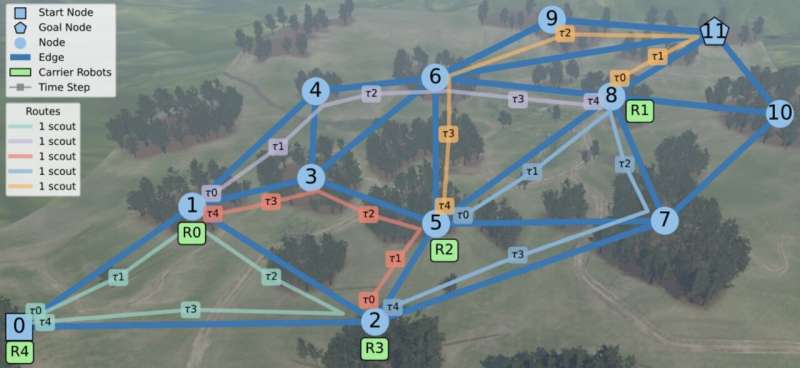November 18, 2023 feature
This article has been reviewed according to Science X's editorial process and policies. Editors have highlighted the following attributes while ensuring the content's credibility:
fact-checked
preprint
trusted source
proofread
An approach to plan the actions of robot teams in uncertain conditions

While most robots are initially tested in laboratory settings and other controlled environments, they are designed to be deployed in real-world environments, helping humans to tackle various problems. Navigating real-world environments entails dealing with high levels of uncertainty and unpredictability, particularly when robots are completing missions as a team.
In recent years, computer scientists have been trying to develop frameworks and models that could improve the ability of robots to effectively solve problems outside of laboratory settings, where they are more likely to encounter unforeseen challenges. These computational tools could ultimately facilitate the widespread adoption of robots, enhancing their ability to successfully complete missions.
A research team at Johns Hopkins University recently introduced a new framework designed to plan the actions of robots in a team while also considering the uncertainty under which they are operating. Their proposed approach, introduced in a paper pre-published on arXiv, builds on a computational method first introduced in one of their previous works.
"Planning under uncertainty is a fundamental challenge in robotics," Cora A. Dimmig, Kevin C. Wolfe and their colleagues wrote in their paper. "For multi-robot teams, the challenge is further exacerbated, since the planning problem can quickly become computationally intractable as the number of robots increase. We propose a novel approach for planning under uncertainty using heterogeneous multi-robot teams."
The approach proposed by Dimmig, Wolfe and their collaborators applies to scenarios in which different robots in a team can take on different roles, as all the robots collectively work to complete a common mission outdoors. Essentially, the team introduce the notion that some robots, which move at higher speeds, could act as scouts during a given real-world mission, patrolling unknown or uncertain geographical regions ahead to identify potential challenges and better plan the actions of all the other robots.
"This enables investigating both planning to minimize the risk associated with uncertainty in proposed paths as well as planning to minimize the overall uncertainty in the environment," the researchers explained in their paper.
The method for planning the actions of robot teams introduced by Dimmig, Wolfe and their colleagues relies on two main programming approaches, namely the creation of a dynamic topological graph and so-called mixed-integer programming. The team's approach involves the deployment of two different types of robots. The first type is tasked with completing missions, while the second scouts the environments to collect data and reduce uncertainty, facilitating a task's completion.
So far, the researchers have evaluated their approach computationally on various possible scenarios that could introduce uncertainty during real-world missions. Their findings were promising, suggesting that their proposed method could help to improve the performance of robot teams on tasks that contain varying degrees of uncertainty.
"We test our approach in a number of representative scenarios where the robot team must move through an environment while minimizing detection in the presence of uncertain observer positions," the researchers wrote. "We demonstrate that our approach is sufficiently computationally tractable for real-time re-planning in changing environments, can improve performance in the presence of imperfect information, and can be adjusted to accommodate different risk profiles."
In the future, the new approach developed by Dimmig, Wolfe and their collaborators could be tested further using both simulated and physical robots to validate its potential. In addition, this recent work could inspire other research teams to develop similar methods to enhance the performance of robots in complex real-world environments, ultimately facilitating their large-scale deployment.
More information: Cora A. Dimmig et al, Uncertainty-Aware Planning for Heterogeneous Robot Teams using Dynamic Topological Graphs and Mixed-Integer Programming, arXiv (2023). DOI: 10.48550/arxiv.2310.08396
© 2023 Science X Network


















